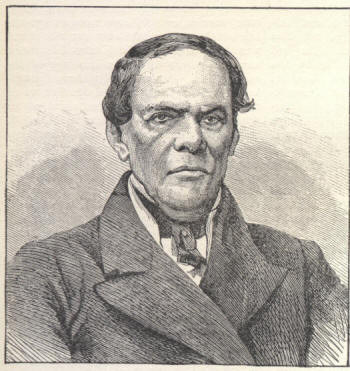Santa Anna
![]()
This Site:
|
Santa Ana, ANTONIO LOPEZ DE, military officer ; born in Jalapa, Mexico, Feb. 21, 1798; began his military career in 1821 in the revolution by which Mexico achieved its independence of Spain. Imperious, disobedient, and revengeful, he was dismissed from the service. A keen intriguer, he secured the overthrow of the existing government in Mexico in 1828. He was a brave and rather successful military leader, and led insurrection after insurrection, until in March, 1833, he obtained his election to the Presidency of the republic of Mexico. He was a favorite with the army, but unpopular with the natives. |
Santa Anna |
There were repeated insurrections during his administration, and finally, discontents in Texas broke out into revolution. Santa Anna took the field in person against the revolutionists. He was personally in charge of the Mexican Army at the battle of the Alamo (March, 1836), and he was responsible for the brutal and treacherous massacre at Goliad (March 1836). He pursued Sam Houston across Texas in what is known as the "Runaway Scrape". He was defeated at the battle of San Jacinto by General Sam Houston, and taken prisoner. He was deposed from the Presidency. In taking part in defending Vera Cruz against the French in 1837 he was wounded and lost a leg by amputation. In the long contest between the Federalists and Centralists, taking part with the former, he was virtually dictator of Mexico from Oct. 10, 1841, to June 4, 1844, under the title of provisional President. He was constitutional President from June 4 to Sept. 20, 1844, when he was deposed by a new revolution, taken prisoner near Tlacolula, Jan. 15, 1845, and banished for ten years. He took up his residence in Cuba, where he secretly negotiated for the betrayal of his country to the United States. He was allowed to pass through Commodore Conner's fleet into Mexico, where he was appointed generalissimo of the army, and in December was again elected provisional President. With an army of 20,000 men he lost the battle of Buena Vista. He was afterwards defeated in battle at Cerro Gordo, and about the middle of September, 1847, was driven with nearly 2,000 followers from the city of Mexico. He was deposed, and in April, 1848, fled from the country to Jamaica. He returned to Mexico in 1853, where he was received with great enthusiasm and appointed President for one year, after which time he was to call a constitutional Congress; but he fomented a new revolution by which he was declared President for life, with power to appoint his successor. He began to rule despotically, and was soon confronted by a revolution led by General Alvarez. After a struggle of two years, he signed his unconditional abdication, and sailed for Cuba, Aug. 16, 1855. He afterwards spent two years in Venezuela, and thence went to St. Thomas. During the French military occupation of Mexico he appeared there and pledged himself to take no part in public affairs. But his passion for intrigue could not be repressed, and having issued a manifesto calculated to raise a disturbance in his favor, General Bazaine ordered him to quit the country forever in May, 1864. Some time afterwards, the Emperor Maximilian made him grand-marshal of the empire; but in 1865, having been implicated in a conspiracy against the Emperor, he fled to St. Thomas. In 1867 he again made an attempt to gain ascendency in Mexico, but was taken prisoner at Vera Cruz and condemned to be shot. President Juarez pardoned him on condition of his quitting Mexico forever. He came to the United States. After the death of Juarez he was permitted to return to his native country, and afterwards lived in seclusion in the city of Mexico, where he died, June 20, 1876. |
|
![]()
|
Site Copyright © 2003-2018 Son of the South. For questions or comments, contact paul@sonofthesouth.net. |
|
|
|
Are you Scared and Confused? Click Here to read My Snake Story, a story of hope and encouragement, to help you face your fears. |
||
